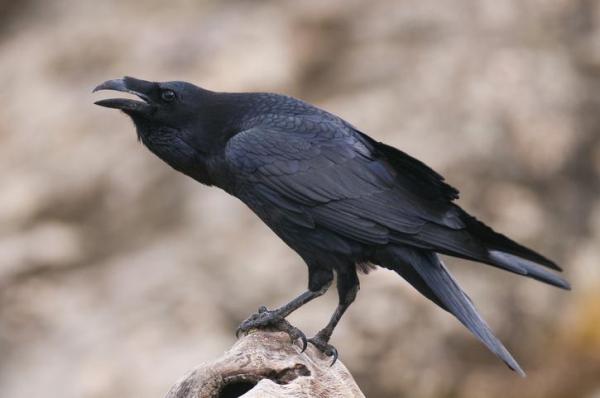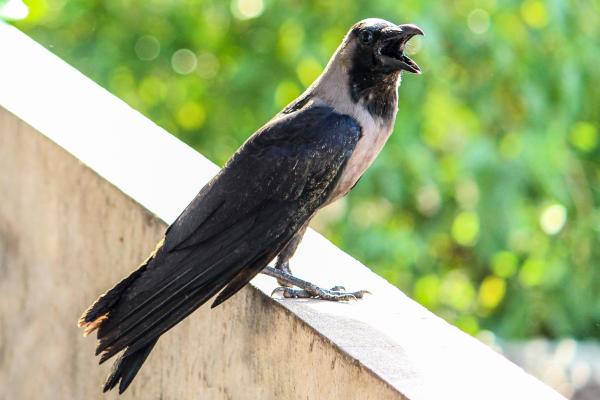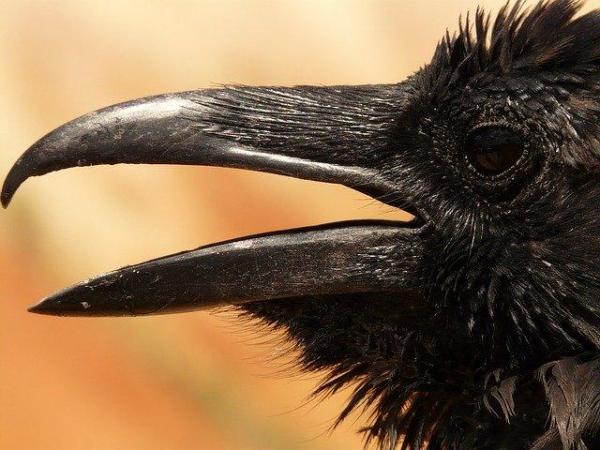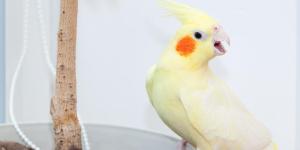Can Crows Talk Like Humans?


Crows can talk in that they can mimic the same sounds of human speech. They can also mimic the sounds of other birds and animals. This does not mean they can have a conversation the way humans can, but they can learn to associate certain human sounds with certain actions. Although crows have many cultural associations with humans, their intelligence is far too often overlooked. They can learn how to perform relatively complex tasks. Although they can be tamed, it is important to remember crows are not domesticated like parrots. This does not mean they do not have similar vocal abilities.
At AnimalWised, we look in more detail at how crows mimic human speech by asking can crows talk like humans? We learn more about the vocal ability of crows, as well as other characteristics of these incredibly intelligent birds.
Crow vocalizations
Birds are known for their vocalizations with some birds even being defined by this ability, such is the case with songbirds. While some birds are more vocal than others, the ability to make noise is incredibly important for intraspecies communication. This is the communication between birds of the same species. It allows them to carry out various behaviors related to mating, feeding and other vital processes.
Using vocalization sounds is important from the beginning of a bird's life. Chicks will call to their parents when they are hungry and also simply allow them know they are alive. During their development, they will adapt their vocalizations to their needs. These needs are related to their social environment and will differ according to species[1]. For example, some birds are more solitary than others, meaning they may call out less.
Crows are birds from the genus Corvus and include common species such as the American crow (Corvus brachyrhynchos), the carrion crow (Corvus corone) and the common raven (Corvus corax). Crows, ravens and rooks are names for different members of the Corvus genus, although the differences between these birds are often difficult to specify. Generally speaking, their differences are dependent on size.
These birds are incredibly intelligent. Some research suggests they have an intelligence equivocal to some primates[2]. For this reason, they have more intricate types of communication than many other animals and can convey relatively complex emotions. Vocalizations are the most common type of communication in crows.
What sounds do crows make?
As stated above, birds will use their vocalizations for different purposes and crows are no exception. They are not songbirds, so they do not chirp and chirrup like some birds. Their sounds are often more harsh and are most typified by the caw sound with which crows are most associated. Despite being drastically different in terms of tone, timbre, pitch and rhythm from some other birds, the reasons crows make sounds are essentially the same.
Generally speaking, crows make two types of sound:
- Structured vocalizations: in these cases, the crow is using their vocalizations for calls which are part of their normal behavior. They are usually directed to other calls and are an important part of their routine. For example, they make make calls when it is time to roost.
- Unstructured vocalizations: these are calls which are usually a response to a particular stimuli, although it can also be related to problems with their wellbeing. In these cases, something is eliciting a call from the bird. An example can be seen when the bird is threatened by a predator. The type of call will depend on the context of the situation.
While the crow's vocalizations will fall into these general categories, there are many specific vocalizations for specific purposes. Different types of crow species will also have variations in their vocal sounds. Their vocalizations will also change according to their We don't always know the exact reason for each sound and their meaning will also depend on the context. Some examples of crow sounds include:
- Caw: this is a very versatile sound which can be used for communication with other crows, warn off predators or convey various types of information. They can be of varying pitch and intensity. Learn more about these specifics with our article on the reasons why crows caw.
- Coo: although we may associate this sound more with birds like the pigeon, crows can also make softer sounds. This is often done to their young or during mating.
- Rattle: crows will often rattle their beak or make a clicking sound. This is often associated with mating and may be part of the mating ritual.
- Squawk: often used when they feel they are in danger or they want to convey information quickly.
- Whine: most associated with young crows and will often be associated with wanting something, especially food. They will often use it with their siblings when squabbling over something. Adult crows can make similar sounds when squabbling.
The duration and intensity of the crow's call will depend on the context. They can respond with different emotions to various stimuli, making different patterns as they do so. It is their versatility of vocalization that leads us to wonder can crows talk?

Can crows talk?
The question of whether crows can talk like humans requires greater clarity. If we are asking whether crows can mimic human speech, then the answer is yes. You may have seen YouTube videos of crows mimicking human speech. They can create various sounds which are very similar to human speech. These are often elicited by a human guardian when the same sound is used as a prompt.
What is more complicated is whether crows can speak like humans. Human speech is the vocal communication of humans using language. Crows do not speak our language. They do know speak English or any other human language, meaning we cannot have a conversation with them. In this way, crows can talk like parrots, but not like humans.
Birds like crows and parrots can mimic the sounds of humans. They can also learn how to associate certain sounds made by humans with specific actions or emotions. In this way, they can be trained to carry out certain tasks in response to words used by humans. This is similar to how other animals such as dogs can be taught certain tasks.
The intelligence of crows allows them to be able to mimic speech in this way. Not only can crows mimic the human voice, but they can make other anthropogenic sounds such as laughter or coughing. Since crows have excellent memory, they can remember these sounds in the future to make them again.
Although you may see humans talking to crows and eliciting a response, this is not the same as the crow being able to speak like a human. They do not know the specific emotions and meanings behind language used. They can simply attach a certain sound to a certain experience. It is important to make the distinction between mimicking human speech and being able to speak like a human.
How do crows talk like humans?
Now we know that crows can mimic the speech of humans just like parrots and certain other birds, we will want to know how they are able to do so. Crows can listen to a model sound made by a human, memorize it and practice it until they match the original sound. They can only do so because they have the anatomical structures which can allow it. For example, an octopus is known for their intelligence, but not for their ability to vocalize.
Crows can mimic human speech thanks to a structure known as the syrinx. This is the equivalent to the vocal cord in humans. It is a cartilaginous expansion covered by muscles and is located at the lower end of the trachea where it branches into two bronchi before entering the lungs. It does not have the vocal folds of mammalian animals, but it uses vibrations to create similar sounds.
The syrinx is formed by modifications of the tracheal rings, the bronchial semirings or a combination of both. The sounds are produced by vibration produced by the air passing through the walls of this organ. In some bird species, such as the crow, these vibrations allow them to reproduce even the human voice. Songbirds have a more developed syrinx and can make incredible variations with this organ.

How to teach a crow how to talk like a human
Teaching a crow to talk like a human is a highly complex task and is not a common practice. While crows have the ability to mimic sounds, including some human speech, it's important to note they cannot mimic all types of human speech. This is due to the limitations created by their vocal anatomy. However, there are some circumstances where a crow can be taught to imitate human speech:
- Choose the right crow: it's crucial to work with a captive-bred crow that has been hand-reared and is accustomed to human presence. Although we might hear a wild crow imitate human speech of their own volition, they may not be suitable for this type of training.
- Establish trust and bonding: spend time building a strong bond with the crow through positive reinforcement, patience and consistent interaction. This will help create a foundation of trust and facilitate the training process.
- Vocalization exposure: play recordings of human speech or desired words to the crow regularly. Hearing the sounds repeatedly will help familiarize the crow with the patterns and tones of human speech.
- Repetition and reinforcement: select a specific word or phrase and consistently repeat it in the presence of the crow. Use a calm and clear tone while emphasizing the chosen word. Pair the repetition with positive reinforcement, such as treats or praise, to encourage the crow's interest and participation.
- Imitation training: since the crow is familiar with the desired word or phrase, try to encourage imitation. Start by saying the word or phrase and then pause, giving the crow an opportunity to respond. If the crow makes any vocalizations or attempts to imitate, reward it with positive reinforcement.
- Gradual progress: patience is key, as crows may take a long time to show progress or may not fully mimic human speech. It's essential to recognize and celebrate even small attempts or approximations of the desired sounds.
- Environmental enrichment: provide the crow with a stimulating and enriched environment to keep them mentally engaged. This can include puzzles, toys and interactive objects, which may indirectly support vocalization learning.
Teaching a crow to talk like a human is an experimental and challenging task. It is uncertain whether a crow can fully acquire human speech due to differences in vocal anatomy and natural vocalizations. It's crucial to prioritize the crow's wellbeing, ensuring they receive proper care and enrichment while respecting their natural behaviors and limitations.

Can ravens talk like humans?
This article has been referencing a crow's ability to mimic. Ravens are a type of crow since they also are a species in the genus Corvus. In fact, a raven is a larger type of crow, meaning their syrinx may be able to create a deeper or even more complex range of vocalizations.
The raven's ability to talk like a human is also related to their highly developed memory. Not only can they mimic human speech, they have been known to recognize the meanings of human gestures[3]. This shows that raven communication is highly developed just like those of other crows. The ability of any type of crow to speak like humans is dependent on various factors,.
If you want to read similar articles to Can Crows Talk Like Humans?, we recommend you visit our Facts about the animal kingdom category.
1. Sasahara, K., Cody, M. L., Cohen, D., & Taylor, C. E. (2012). Structural design principles of complex bird songs: a network-based approach. PloS one, 7(9), e44436.
https://doi.org/10.1371/journal.pone.0044436
2. Emery, N. J., & Clayton, N. S. (2004). The mentality of crows: convergent evolution of intelligence in corvids and apes. Science (New York, N.Y.), 306(5703), 1903–1907.
https://doi.org/10.1126/science.1098410
3. Pika, S., & Bugnyar, T. (2011). The use of referential gestures in ravens (Corvus corax) in the wild. Nature communications, 2, 560.
https://doi.org/10.1038/ncomms1567
- Bluff, L . A., Kacelnik, A., & Rutz, C. (2010). Vocal culture in New Caledonian crows Corvus moneduloides. Biological journal of the Linnean Society, 101(4), 767-776.
- Heyes, C.M. (1993). Imitation, culture and cognition. Animal Behaviour, 46(5), 999-1010.
- Tsukahara, N., Yang, Q., & Sugita, S. (2008). Structure of the syringeal muscles in jungle crow (Corvus macrorhynchos). Anatomical science international, 83(3), 152-158.







